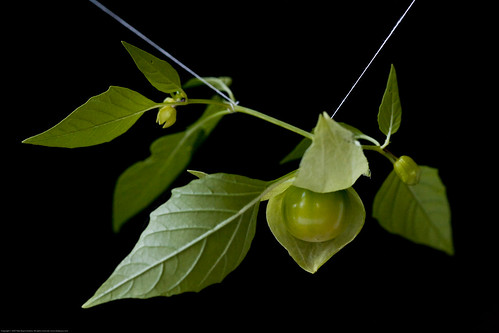LENTILS

Leaves and pod of one type of lentil plant, the black beluga
(Photo from Bucky's Barbecue & Bread food photography blog)
One reader doesn't think the above photo is of a lentil plant -- even though it is a particular and unusual kind of lentil, the black beluga lentil, which has been hung on a wire for the purposes of photography -- so here's another photo that is more obviously of a lentil plant:

Harder to see the lentils here, isn't it?
(Photo from Energy Farms Network)

Only three of the different varieties of lentils
(Photo from eHow)
Categorized as:
- Fruit
- Pulse
- Sometimes also called daal
- Species name: Lens culinaris
General facts:
- Lentils grow in pods that contain one or two seeds.
- They are among the first foods to have been cultivated. They're very easy to grow and to this day, they are extremely inexpensive.
- Lenses are so-named because they are shaped like lentils. In other words, that's how old they are: people knew about lentils long before they knew about lenses.
- Once upon a time in Ancient Greece, Hippocrates prescribed a dish of lentils and sliced dog to treat liver ailments. I do not recommend the sliced dog.
- They've been a staple in civilizations around the world for centuries. In Europe, Catholics who couldn't afford fish ate them during Lent, so they got branded as what you eat when there's nothing else.
- By the way, Lent is not named after lentils, but it seems to be a descendant of the word "long" or "lengthen" because Lent lasts a long time (40 days, to be exact).
- In the Middle East, India, and Southeast Asia, lentils remain wildly popular. In India, "any self-respecting household" eats lentils in some form at least twice a day.
- Very popular source of protein for vegetarians.
- One cup of lentils gives you 90% of your daily requirement of folic acid -- more than any other food. Folate is very important for women who are or will shortly become pregnant because it helps to reduce the risk of birth defects.
- There are all sorts of varieties of lentils. They range in color from yellow to green to red to black. Green are popular with the Europeans and Americans, while red are more popular with folks in the Middle East.
- Black lentils are very high in antioxidants.
- As with most fruits, the smaller varieties are more flavorful, but of course the Americans like 'em big.
- Dry lentils don't need to be pre-soaked, but they do need to be cleaned, rinsed, and cooked.
- Get the water boiling first. With lentils, this will help reduce the gas the beans retain. Add the lentils, bring back to a boil, then simmer. Green lentils take about 30 minutes, red ones only 20.
- They taste better if you add a peeled onion that you've cut into hunks.
- When they're ready, pour olive oil over the lot, scoop 'em onto buttered toast, add salt, pepper, garlic salt, and maybe some of your favorite cheese, and you've got dinner.
- Literally thousands of recipes using lentils are available here at RecipeZaar.
Next bean on the menu: green beans.
Sources
National Lentil Festival, Lentil Facts & Lore
FoodReference.com, Lentils
Healthy Eating, World's Healthiest Foods: Lentils (India)
The World's Healthiest Foods, Lentils
Thoughtful Foods, Lentils
Cambridge Advanced Learner's Dictionary, legumes
USDA Plants Database, Classification Down to Family Fabaceae
FAO, Definition and Classification of Commodities, 4. Pulses and Derived Products
NationMaster, Encyclopedia, Pulses
Wikipedia, Fabaceae and pulses
"Lentils are named after the fact that they are shaped like lenses."
ReplyDeleteActually, its the other way around.
Gasp! Anonymous, I was all set to retort, but first I consulted the big guns -- my OED, but it was annoyingly vague. Then I checked my falling-apart Latin dictionary, and you are correct! The sources upon which I based my original statement got it wrong!
ReplyDeleteI have amended my error in the entry. Thanks for the correction. :)
Pretty sure that isn't a lentil plant in the picture.
ReplyDeleteDespite anonymous comments- I liked this post. Good info and I always wondered what a lentil plant looked like. Thank you for sharing.
ReplyDelete